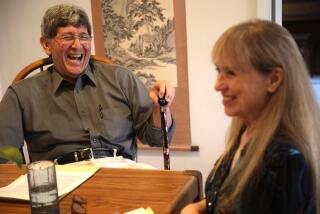Surviving Cancer: Children Live to Find Problems Outlast Disease : Medicine: Clinics now counsel parents and patients about side effects and warning signs that can crop up years after remission.
- Share via
ATLANTA — As a teen-ager, Lesley Stanfield breezed through chemotherapy and survived a risky bone marrow transplant without a thought of dying.
Now, at 21, Stanfield is filled with anxiety about possible side effects from her treatment for stomach cancer years ago. Her heart remains weak and she firmly believes the rest of her body will break down in time. She frantically fills every minute of her day, believing she must live to the fullest while she is still healthy.
Stanfield is one of a growing number of adults nationwide who survived cancer as children only to believe years later that the intensive cancer treatments may have left a permanent scar--physically, emotionally or financially.
“This year, I’ve been a little bit more anxious and had a higher level of stress than normal,” says Stanfield, a student at the University of North Carolina. “My doctors have associated it with my treatment. I want to know now what’s going to break down so I can prepare for it.”
Her annual checkups at the cancer clinic at Scottish Rite Children’s Medical Center in her hometown of Atlanta help to ease her mind, but Stanfield is sure that the doctors will have bad news one day.
“I get scared stiff going back there for checkups, but at least they’re there for me,” she says. “It scares me that they don’t think I need chemotherapy or any kind of treatment anymore.”
As the survival rate for children with cancer continues to improve, clinics such as Scottish Rite are devoting more and more time to tracking the children long after their cancer has disappeared. They monitor patients well into adulthood for signs of new cancers, learning difficulties, emotional problems and economic woes.
“The philosophy used to be, ‘Let’s just try to get these children to survive.’ We’re now realizing we have our work cut out for us after survival,” says Lisa Groth, the staff psychologist at the Scottish Rite clinic.
Before the early 1980s, scant attention was paid to the possible adverse effects of cancer treatment because the number of survivors was low. While the survival rate for adults remains about 20%, the rate for children has jumped to about 70%.
But as the number of childhood survivors grew, so did the number of long-term side effects from their treatment.
A 1992 study of about 350 childhood cancer survivors at Childrens Hospital Los Angeles found that 40% reported physical or emotional side effects from their treatments.
The problems include learning disabilities, infertility, cataracts, stunted growth, heart problems, brittle bones and a fear of getting a second cancer or having children with cancer.
“When I tell a parent about the possible side effects their child faces, I start with the brain and work my way down the entire body,” says Dr. John Bergsagel, head of the Scottish Rite clinic.
As a result, childhood survivors are less likely to marry or have children than people who never have had the disease, the Los Angeles study showed.
“They’re very conservative,” says Dr. Daniel Hays, professor of surgery and pediatrics at the University of Southern California medical school. “They’ve already had a major and traumatic event in their lives, and they’re not willing to take chances as other people.”
Among cancer survivors who were dating, the study showed that about one-fourth believe enduring the lengthy cancer treatments has affected their relationships, mostly negatively.
Paddy McNeirney, 20, of Fairburn, Ga., survived a malignant tumor in his leg during high school but now has a girlfriend he says is jealous of the close ties that he enjoys with the staff and patients at Scottish Rite. He underwent 9 1/2 months of chemotherapy there.
At the height of his treatment, McNeirney made the hourlong trip five days a week to receive chemotherapy intravenously for several hours at a time. He often spent the ride home vomiting; eventually he lost his hair.
He became close friends with the staff and other patients--some of whom have died--and he looks forward to his checkup visits.
“I told my girlfriend about the cancer right away,” McNeirney says. “I do know that she’s kind of jealous of the fact that I have these ties. She feels that they’re closer to me than she is because they shared that experience with me and she didn’t.”
Childhood cancer survivors also face problems such as rejection by insurance companies, or trouble completing their education and holding a job because of learning difficulties.
Two-year-old Chamiya Brown of Hartwell, Ga., will be monitored until she is at least 12, after surviving four surgeries, a liver biopsy and intense chemotherapy to send her leukemia into remission. Her mother, 22-year-old Patrice Brown, already has lost one child to disease and dutifully makes the two-hour drive to Scottish Rite five times a year so doctors can monitor Chamiya’s progress.
“They haven’t found anything wrong yet, but they won’t know for a few years,” says Brown, a beautician and single mother. “I had just gotten over the death of my first baby when she was diagnosed. I don’t want the same thing to happen to my second child.”
McNeirney hasn’t suffered any physical problems either, but he blames the lengthy cancer treatment for erasing his chance to go away to college with his high school buddies. He had almost completed treatment by the time he was ready for college, but his parents wanted him to stay close to home so he could continue to be monitored at Scottish Rite.
McNeirney now attends a small college near his home, but he also works two jobs to support himself. He said cancer and the treatment for it stole a piece of his youth.
“I look at it as like I missed out on the college life, where you go away to school somewhere and go to parties and join fraternities,” he says. “But I’m kind of glad that the doctors still do the checkups. It’s a sense of security.”
By the year 2000, there will be 210,000 survivors of childhood cancer in the United States. About 8,000 children each year are diagnosed with the disease, and most of the problems that arise from their harsh treatment won’t show up for years after the cancer is gone.
“You can’t give adequate care to children with cancer unless you monitor the long-term effects. Just curing them isn’t doing the whole job,” says Bergsagel of the Scottish Rite clinic.
“If we don’t follow up with our patients, we can’t make medical progress. It’s hard for us to see now how we couldn’t have followed up.”
The problems surfacing among childhood cancer survivors are forcing the medical industry to refine treatment methods, Hays said.
“It will mean that we have to look at these new treatments and say, ‘Are they really an advance in curing cancer and what do they do down the road?’ ” Hays says. “Are we giving up too much for what we’re getting?”
More to Read
Sign up for Essential California
The most important California stories and recommendations in your inbox every morning.
You may occasionally receive promotional content from the Los Angeles Times.










